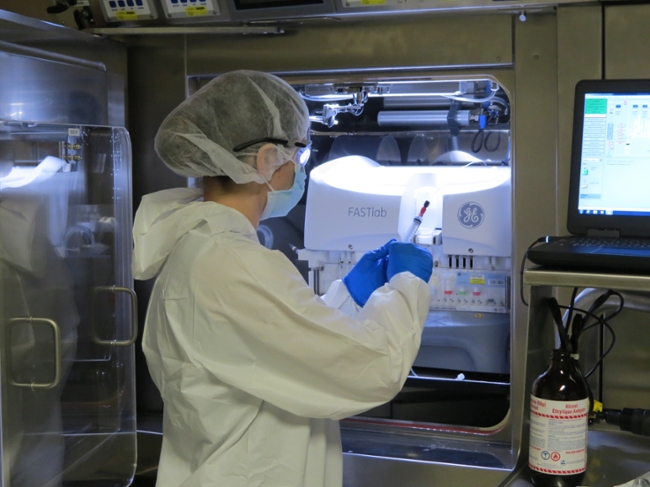
Cyclotron giving Medical Imaging a boost
Saskatchewan cyclotron is now making medical isotopes for use across the province
By Marg SheridanIt’s been a long road from conception to completion for the team working to get the cyclotron at the Saskatchewan Centre for Cyclotron Sciences producing medical-grade isotopes – but in early June that first batch was delivered to the Royal University Hospital (RUH).
“As the distance to our neighbouring large cities is quite large, and the issue with radio isotopes is that they break down over time – they decay,” explained Dr. Paul Babyn, the department head of the Department of Medical Imaging at the College of Medicine, and a member of the team that helped bring medical isotope production to Saskatchewan. “The most common radioisotope that we use, which is Flourine-18, has a half-life of 110 minutes which means that after just less than two hours 50 per cent of what you started with is gone.
“And the issue is that you can make a lot, but by the time it gets here from somewhere else you only have a little bit - and that limits the number of patients you can image each day.
And that’s a big deal for nuclear medicine, because up until recently Saskatoon Health Region needed to ship isotopes from Hamilton, Ont., which is over 2,200km from Saskatoon. And starting to supply the isotopes in-house was important before the cyclotron in Hamilton, at McMaster University, sees their demand for medical isotopes increase as the Chalk River reactor in Ontario is slated to close in 2018.
And while the cyclotron in Saskatoon, operated by the Fedoruk Centre, has been producing radioisotopes for several months now, last month was the first production of F18- Fluorodeoxyglucose – the radiopharmaceutical most needed for PET imaging at RUH.
“This is the first F18-isotope, and that’s the radio-isotope we use most frequently,” continued Babyn. “This is the first of I think many radiopharmaceuticals that will be coming down the road that will be labelled with F18 – There are a number of other radiopharmaceuticals and tracers that can be made with the same backbone (F18), so those will probably be some of the next ones that we do here in Saskatchewan.”
Babyn, who graduated from McGill University before studying radiology in Philadelphia and completing a fellowship at the Hospital for Sick Children (SickKids) in Toronto, went on to work at SickKids for 23 years before being drawn to the CoM as the department head for imaging, played a role in the strategic planning behind the isotope production.
“It’s a large team,” Babyn stressed. “The cyclotron work is done primarily by the university group and the Fedoruk Centre, (and) we have nuclear medicine physicians, three of those here in Saskatoon, and a number of technologists who work in the PET-CT facility that provides the scanning and daily interaction with the patients.
“You need expertise in ensuring you’re doing it with quality and safety in mind – it’s a culmination of a lot of effort by many different individuals.”
